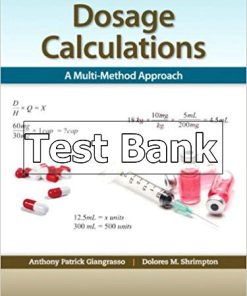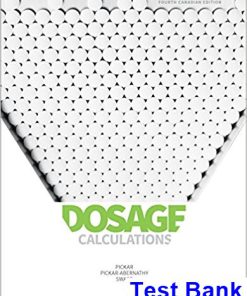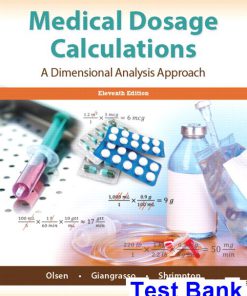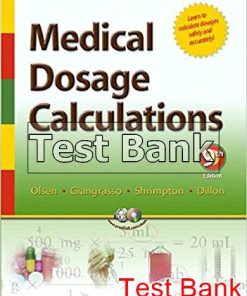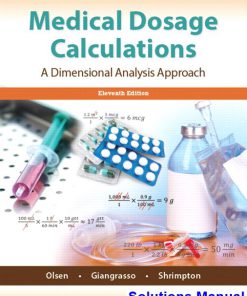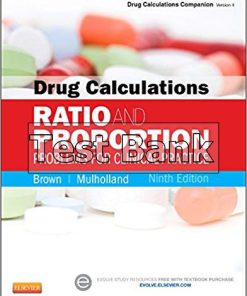Dosage Calculations 9th Edition Pickar Test Bank
You may also like
Dosage Calculations 9th Edition Pickar Test Bank
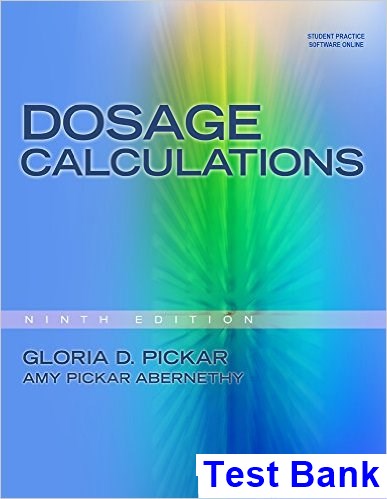
Product details:
- ISBN-10 : 9781439058473
- ISBN-13 : 978-1439058473
- Author: Gloria D. Pickar, Amy Pickar-Abernethy
Best-selling DOSAGE CALCULATIONS, 9th Edition features the three-step approach to basic and advanced Formula Method calculations that nursing and other health care professionals prefer, along with a reader-friendly writing style and handy “work text” format. In addition to easing readers into the math with a thorough review, the book uses a logic-based process to build confidence and limit anxiety. Featuring full-color images of drug labels, critical thinking assessments, extensive clinical examples, and a host of interactive supplements, including an accompanying online tutorial, DOSAGE CALCULATIONS, 9th Edition provides the skills needed to master dosage calculations in any clinical setting!
Table contents:
- Section 1: Pretest and Mathematics Review
- Essential Skills Evaluation: Pretest
- Essential Skills Evaluation: Pretest Answer Sheet
- Ch 1: Fractions and Decimals
- Fractions
- Decimals
- Ch 2: Ratios, Percents, Simple Equations, and Ratio-Proportion
- Ratios and Percents
- Solving Simple Equations for X
- Ratio-Proportion: Cross-Multiplying to Solve for X
- Finding the Percentage of a Quantity
- Section 1 Self-Evaluation
- Section 2: Measurement Systems, Drug Orders, and Drug Labels
- Ch 3: Systems of Measurement
- Metric System
- Apothecary and Household Systems
- Other Common Drug Measurements: Units and Milliequivalents
- Ch 4: Conversions: Metric and Household Systems
- Identifying Need for Unit Conversion
- Converting from One Unit to Another Using the Conversion Factor Method
- Converting within the Metric System
- Approximate Equivalents
- Converting between Systems of Measurement Using the Conversion Factor Method
- Ch 5: Conversions for Other Clinical Applications: Time and Temperature
- Converting between Traditional and International Time
- Converting between Celsius and Fahrenheit Temperature
- Ch 6: Equipment Used in Dosage Measurement
- Oral Administration
- Parenteral Administration
- Ch 7: Interpreting Drug Orders
- Medical Abbreviations
- The Drug Order
- Medication Order and Administration Forms
- Computerized Medication Administration Systems
- Ch 8: Understanding Drug Labels
- Brand and Generic Names
- Dosage Strength
- Form
- Supply Dosage
- Total Volume
- Administration Route
- Directions for Mixing or Reconstituting
- Label Alerts
- Name of the Manufacturer
- Expiration Date
- Lot or Control Numbers
- National Drug Code (NDC)
- Controlled Substance Schedule
- Barcode Symbols
- United States Pharmacopeia (USP) and National Formulary (NF)
- Unit- or Single-Dose Labels
- Combination Drugs
- Supply Dosage Expressed as a Ratio or Percent
- Checking Labels
- Ch 9: Preventing Medication Errors
- Prescription
- Transcription
- Safe Medication Administration
- The Nurse’s Critical Role in Medication Error Prevention
- Section 2 Self-Evaluation
- Section 3: Drug Dosage Calculations
- Ch 10: Oral Dosage of Drugs
- Tablets and Capsules
- Three-Step Approach to Dosage Calculations
- Oral Liquids
- Ch 11: Parenteral Dosage of Drugs
- Injectable Solutions
- High-Alert Parenteral Medications
- Ch 12: Reconstitution of Solutions
- Solution Properties
- Reconstitution of Injectable Medications in Powder Form
- Types of Reconstituted Parenteral Solutions
- Reconstituted Parenteral Solutions with Various Routes
- Reconstitution of Noninjectable Solutions
- Topical Solutions and Irrigants
- Oral and Enteral Feedings
- Ch 13: Pediatric and Adult Dosages Based on Body Weight
- Administering Medications to Children
- Converting Pounds to Kilograms
- Body Weight Method for Calculating Safe Pediatric Dosage
- Combination Drugs
- Adult Dosages Based on Body Weight
- Ch 14: Alternative Dosage Calculation Methods: Ratio-Proportion and Dimensional Analysis
- Converting Using the Ratio-Proportion Method
- Using Ratio-Proportion to Calculate Dosages
- Using Dimensional Analysis to Calculate Dosages
- Section 3 Self-Evaluation
- Section 4: Advanced Calculations
- Ch 15: Intravenous Solutions, Equipment, and Calculations
- IV Solutions
- Calculating Components of IV Solutions When Expressed as a Percent
- IV Sites
- Monitoring IVs
- Primary and Secondary IVs
- Blood Administration Tubing
- IV Flow Rate
- Electronically-Regulated IVs
- Calculating Flow Rates for Infusion Pumps in mL/h
- Manually-Regulated IVs
- Calculating Flow Rates for Manually-Regulated IVs in gtt/min
- Adjusting IV Flow Rate
- Intermittent IV Infusions
- Calculating IV Infusion Time and Volume
- Ch 16: Body Surface Area and Advanced Pediatric Calculations
- Body Surface Area Method
- Pediatric Volume Control Sets
- Minimal Dilutions for IV Medications
- Calculation of Daily Volume for Maintenance Fluids
- Ch 17: Advanced Adult Intravenous Calculations
- Calculating IV Dosages and Flow Rates Using Clinical Protocols
- Critical Care IV Calculations: Calculating Flow Rate of an IV Medication to be Given over a Specifie
- Limiting Infusion Volumes
- Section 4: Self-Evaluation
- Essential Skills Evaluation: Posttest
- Comprehensive Skills Evaluation
People also search:
Dosage calculations 9th edition pdf
Dosage calculations 9th edition ebook
Dosage calculations 9th edition
Dosage calculations pickar pdf
Dosage calculations ninth edition







